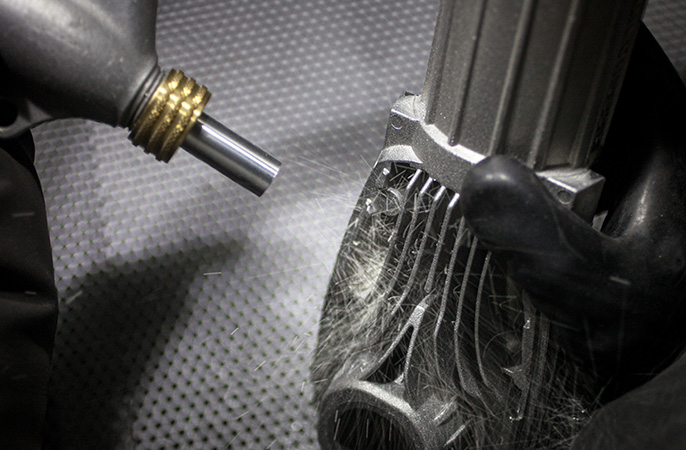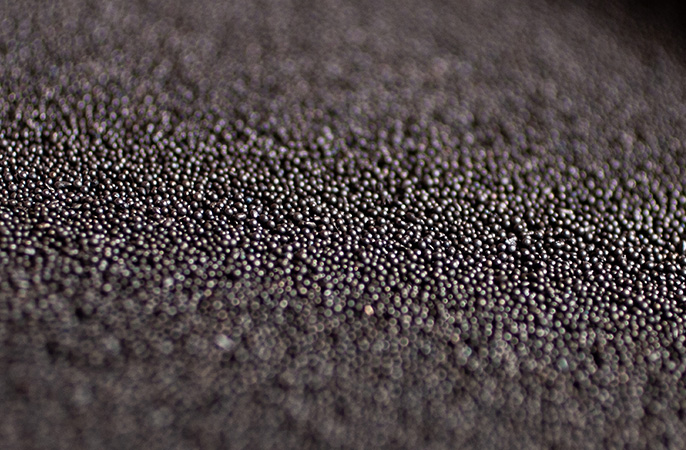
After the production is completed, most of the springs need to be further processed to meet the application requirements, the purpose is to improve the product's wear resistance, rust prevention, surface hardness to increase the life circle. The surface coating treatment can also slightly change the size and thus its physical properties, such as color and reflection. As for the types of surface coatings, there are mainly two major categories of metal and non-metal, and then make a detailed classification according to this.
It can be divided into roller type and U-shaped vibration grinding. Drum type vibration grinder is usually used for general hard objects. The spring usually uses a U-shaped three-dimensional vibration grinder, which is driven by a vibration motor installed at the bottom of the container to drive an eccentric load shaft to drive the U-shaped container to a state of vibration. An abrasive and the grinding stones or a steel balls are placed in the container. When it is actuated, the springs, the abrasive and the steel balls will be mixed, forming a spiral vortex motion to grind and cut or polish the surface of the springs to make the surface of the springs polished. It can also be used to make the surface of the spring smoother. And, the burrs are moderately eliminated.


Some people confuse sandblasting with shot peening. In fact, the equipment and processes are quite different. Sandblasting is mainly to clean the surface of the object, to increase the surface roughness, and to facilitate post-process processing, such as: electroplating, baking paint. Shot peening is the use of high-speed shots of steel balls to the metal surface, causing compressive stress on the metal surface, which can increase fatigue strength, and can seal the cracks and reduce the chance of future fracture. Therefore, shot peening is very important for springs that require high fatigue life. This process has gradually been taken seriously.
Shot peening is also called shot blasting. The medium usually uses iron, steel balls, or cut steel wires, stainless steel wires, etc., and the steel balls are sent to the impeller by driving a carrier similar to a conveyor belt. The impeller will force the steel ball to the springs, hitting the surface at high speed. This impact is like countless small steel shots continuously beating on the surface of the part, so that the surface is covered with small depressions, which can increase the surface hardness and achieve the effect of hardness strengthening. Because this depression will stretch the metal surface layer, the compressed crystal grains under the surface layer will try to restore the surface to its original appearance, thus creating a hemisphere under the action of a high compressive force. Numerous depressions overlap to form a uniform residual compressive stress layer. In areas of compressive stress, cracks will be difficult to form or extend. Almost all fatigue occurs on the surface of the spring or close to the surface. Compressive stress squeezes the crystal grains on the surface to make the crystal grain structure compact, so the compressive stress introduced by the beading can prolong the life circle of the springs.
In order to judge the efficiency and quality of shot peening, an Arman test piece is usually placed together with the springs during shot peening. The arc height and coverage rate measured by the test piece are used as the basis for judging the quality of the shot peening.
The principle of electrolytic polishing is to connect the workpiece to the anode, connect a certain metal to the cathode, and place a direct current in the electrolyte to remove the metal on the surface of the workpiece by electrolysis, that is, reverse electroplating. Under the proper electrolyte and operating conditions, the surface of the workpiece will be eroded, which can remove the burrs, and make the surface of the workpiece shiny and flat. In the case of stainless steel, the elements such as iron, chromium, and nickel all participate in the reverse plating reaction at the same time, and the erosion of the material on the surface of the workpiece occurs, and the surface smoothing effect occurs. In addition to achieving the polishing effect, it can also increase its corrosion resistance, and delay the occurrence of rust spots and corrosion.
Electroplating refers to the process of depositing a layer of metal or alloy layer on the surface of a conductor, such as a metal, by means of an external direct current, an electrolytic reaction in a solution. During electroplating, the article to be plated is connected to the negative electrode (connected to the negative electrode of the battery), the metal to be plated is used as the positive electrode (connected to the positive electrode of the battery), and a solution containing the metal ions to be plated is used as the electroplating solution.
The purpose of electroplating can prevent rust and form a film on the plated object to isolate the outside air and water. The change of surface properties can make the plated object have acid and corrosion resistance.
The most common in electroplating, it has ductility, wear resistance, high corrosion resistance, bright luster, and the disadvantage is that it is not resistant to salt corrosion.
The most versatile surface coating treatment, used for rust prevention of steel products, and has the best rust prevention effect on iron materials. The price is cheap, and the thicker the zinc layer, the better the anti-rust effect. And chromate treatment on the surface can also increase the anti-rust power several times, and there are a variety of colors to choose from.
With softness and ductility, it is often used in electrical and electronic parts. It is non-toxic and weldable. It can make the workpiece easy to weld and has good electrical conductivity. Can resist corrosion.
Chromium is a high-hardness metal, wear-resistant, high-temperature resistant, and corrosion-resistant, and can increase the beauty and durability of objects.
Good conductivity, commonly used in electronics, electrical appliances, medical equipment, chemical industry equipment, and aviation parts.
It has the characteristics of abrasion resistance, corrosion resistance, low porosity, and good contacts. It is suitable for electronics, communication equipment parts, printed circuit contacts, and adapters. The advantage is that it is not easy to oxidize and discolor, but it is expensive.
It is often used as the electroplating bottom layer of glossy nickel, chromium and gold, but it is easy to oxidize and change color, and it is usually protected by transparent paint.
Alloy electroplating refers to a coating containing two or more metal components. The purpose is to obtain better physical properties of each metal, such as corrosion resistance, aesthetics, magnetism, conductivity, high temperature resistance, and so on. The alloy coating is more difficult to control and requires higher skills and experience.
Electroplating is a typical crystalline coating and requires an external current and anode. The disadvantage is that it is impossible to plate the entire surface of a workpiece with a complex surface. The advantage is that the plating speed is faster than chemical plating, and there are a variety of color options.
Electroless nickel plating is a method in which metal and reducing agent are used to produce an autocatalytic reaction on the surface of the material to obtain a coating. At present, there is only one color of pure nickel-phosphorus alloy on the market for electroless plating. As long as the surface of the part is in full contact with the plating solution, the components consumed in the plating solution can replenish any part of the plating layer in time, even for grooves, gaps, and blind holes. Therefore, it can achieve comprehensive and uniform thickness plating for workpieces with complex surfaces. Electroless plating mostly uses food-grade additives, so it is much more environmentally friendly than electroplating.
After the metal is cleaned and the surface impurities and oil stains are cleaned, in order to avoid oxidation and achieve the characteristics of corrosion resistance and wear resistance, surface coating is also one of the options. Generally, the following methods are used:
